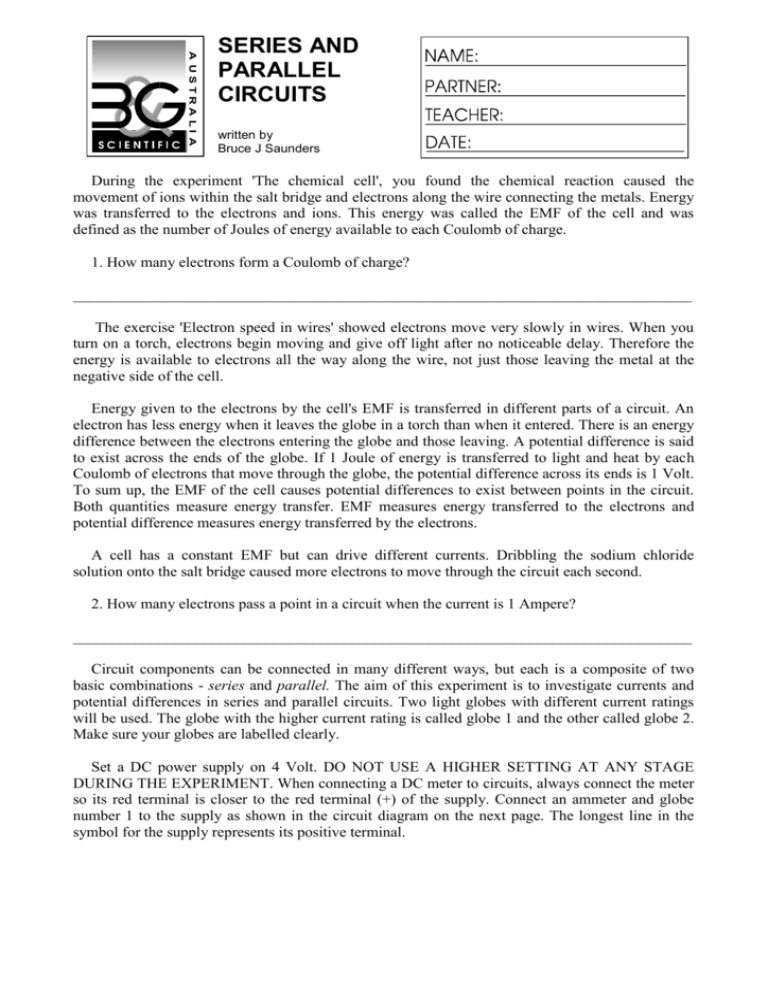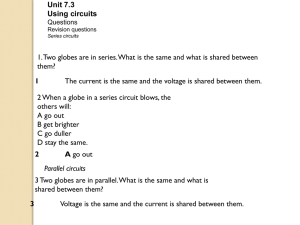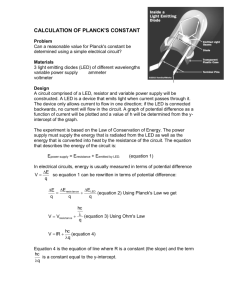Series & Parallel Circuits A4
advertisement

A U STRA LI A SERIES AND PARALLEL CIRCUITS written by Bruce J Saunders During the experiment 'The chemical cell', you found the chemical reaction caused the movement of ions within the salt bridge and electrons along the wire connecting the metals. Energy was transferred to the electrons and ions. This energy was called the EMF of the cell and was defined as the number of Joules of energy available to each Coulomb of charge. 1. How many electrons form a Coulomb of charge? ________________________________________________________________________________ The exercise 'Electron speed in wires' showed electrons move very slowly in wires. When you turn on a torch, electrons begin moving and give off light after no noticeable delay. Therefore the energy is available to electrons all the way along the wire, not just those leaving the metal at the negative side of the cell. Energy given to the electrons by the cell's EMF is transferred in different parts of a circuit. An electron has less energy when it leaves the globe in a torch than when it entered. There is an energy difference between the electrons entering the globe and those leaving. A potential difference is said to exist across the ends of the globe. If 1 Joule of energy is transferred to light and heat by each Coulomb of electrons that move through the globe, the potential difference across its ends is 1 Volt. To sum up, the EMF of the cell causes potential differences to exist between points in the circuit. Both quantities measure energy transfer. EMF measures energy transferred to the electrons and potential difference measures energy transferred by the electrons. A cell has a constant EMF but can drive different currents. Dribbling the sodium chloride solution onto the salt bridge caused more electrons to move through the circuit each second. 2. How many electrons pass a point in a circuit when the current is 1 Ampere? ________________________________________________________________________________ Circuit components can be connected in many different ways, but each is a composite of two basic combinations - series and parallel. The aim of this experiment is to investigate currents and potential differences in series and parallel circuits. Two light globes with different current ratings will be used. The globe with the higher current rating is called globe 1 and the other called globe 2. Make sure your globes are labelled clearly. Set a DC power supply on 4 Volt. DO NOT USE A HIGHER SETTING AT ANY STAGE DURING THE EXPERIMENT. When connecting a DC meter to circuits, always connect the meter so its red terminal is closer to the red terminal (+) of the supply. Connect an ammeter and globe number 1 to the supply as shown in the circuit diagram on the next page. The longest line in the symbol for the supply represents its positive terminal. 2. 3. On the diagram above, mark the red terminal of the ammeter with an 'R' sign. 4. Write the reading on the ammeter next to its symbol on the diagram. 5. Add globe 2 in series with globe 1 as shown in the diagram below. 6. Write the reading on the ammeter next to its symbol on the diagram. Components in electric circuits offer opposition to the flow of electrons. This opposition is called resistance. The total resistance of a circuit depends on the components used and the way they are connected. The greater the total resistance, the smaller the current driven by the cell/power supply. 7. What change occurred to the total resistance of the circuit when the extra globe was added? ________________________________________________________________________________ 8. Move the ammeter to the positions marked with an 'X' in the above diagram and write the current present next to each 'X'. 9. What conclusion can be drawn about the current in a series circuit? ________________________________________________________________________________ 10. In which globe are electrons transferring the most energy?________________________ 11. Across which globe would a voltmeter measure the greater PD?__________ 3. 12. The diagram below shows how to measure the potential difference across globe 1 with a voltmeter. Mark with an 'R', the red terminal of the meter. Note the difference in the type of connections of the meters. The ammeter is connected into the circuit and the voltmeter is added on to the circuit. 13. Connect a voltmeter as shown and write its reading next to the symbol on the diagram. 14. Measure the PD across globe 2 and write its value next to globe 2. 15. Comment on the accuracy of the prediction you made in Q11. ________________________________________________________________________________ 16. Measure the PD across the power supply. The supply must be operating the globes when you make the measurement. State your result. ______________ 17. What is the sum of the PD's across globes 1 and 2? ______________ 18. What conclusion regarding PD around a series circuit, is suggested by your results? ________________________________________________________________________________ ________________________________________________________________________________ Your results should show that the same number of electrons are passing through each globe every second but the globes are not the same brightness. The electrons must find it more difficult to pass through one of the globes. A larger energy transfer occurs when they move through the globe offering the greater opposition to the flow. 19. Which of the two globes has the higher resistance? ________________________ 20. Unscrew one globe. What effect does this have on the circuit? ________________________________________________________________________________ 4. 21. Explain why this occurs? ________________________________________________________________________________ ________________________________________________________________________________ Now connect the globes in a parallel arrangement as shown below. 22. Write the reading on the ammeter next to its symbol on the diagram. 23. Compare this latest reading with the current in the circuit when only globe 1 was present. ________________________________________________________________________________ 24. What change occurs to the total resistance when a parallel connection is added to a circuit? ________________________________________________________________________________ 25. Unscrew globe 1 and watch the ammeter. What change occurred to the current? ________________________________________________________________________________ 26. Repeat the procedure but this time concentrate on the brightness of globe 2. Describe your observations. ________________________________________________________________________________ 27. In which type of circuit are the components working independently of each other? ________________________________________________________________________________ 28. In which type of circuit do changes to one component affect the other components? ________________________________________________________________________________ 29. Move the ammeter to the points in the circuit marked as 'X'. Write the current measured next to each 'X'. 30. What is the sum of the currents through globes 1 and 2? _______________________ 5. 31. Compare your answers to Qs22 and 30. ________________________________________________________________________________ 32. What general rule for the currents in a parallel circuit, is suggested by your results? ________________________________________________________________________________ ________________________________________________________________________________ 33. Use the voltmeter to measure the PD across each globe and write the values next to the globes on the last diagram. 34. What conclusion can be drawn regarding the PD's across components connected in parallel, even though their resistances are not equal? ________________________________________________________________________________ 35. Which of the two globes is the brighter when the two are connected to form: a. a series circuit? ________________ b. a parallel circuit? ___________________ 36. Explain why the relative brightness changes when the type of circuit is changed. Hint - think of which quantity current or potential difference is the same for each type of circuit. ________________________________________________________________________________ ________________________________________________________________________________ ________________________________________________________________________________ ________________________________________________________________________________ ________________________________________________________________________________ 37. Imagine you have two identical globes. What type of connection would cause the total amount of light and heat emitted to be: a. less than the amount emitted by a single globe? ______________________________ b. more than the amount emitted by a single globe? ______________________________ 38. An electric blanket usually contains two identical heating wires. The switch usually enables the blanket to be set on one of three heat settings. 1 - low 2 - medium 3 - high The switch controls the number of the wires connected to the power point and the type of connection between the wires (series or parallel). 6. 39. Complete the following table. Blanket setting No. of wires connected Type of connection 1 2 3 When one battery or supply operates many different circuits, the circuits are in parallel to each other. The battery in a car is a good example. 40. What evidence shows the head lights and tail lights to be in 4 separate parallel circuits. ________________________________________________________________________________ Many circuits are present in a car and this could mean many wires. Consider a wire leaving the battery. It runs to a fuse and a switch. Two wires run from the switch to the back of the car. One is connected to one side of the left-hand tail light and the other connected to one side of the right-hand tail light. 41. Describe the connections of the two additional wires needed for the globes to work. ________________________________________________________________________________ Electrons will move just as easily through the metal body of the car as they will through connecting wire. The two return wires from the tail lights can be scrapped if the sides of the tail lights connected to the negative terminal of the battery are connected to the car body at the back of the car and the negative terminal connected to the car body at the front of the car. Only two wires then run from the front to the back of the car. The earth symbol is drawn on the circuit diagram of a car's wiring to show one side of a battery or component connected to the car body. i.e. 42. Imagine the circuit on page 4 to represent the car battery and the two tail lights. Draw the circuit as it would appear on the wiring diagram of a car. Ignore the fuse and the switch. © Copyright B & G Scientific Pty Ltd 1996. May be copied for student use. Series and Parallel Circuits.








